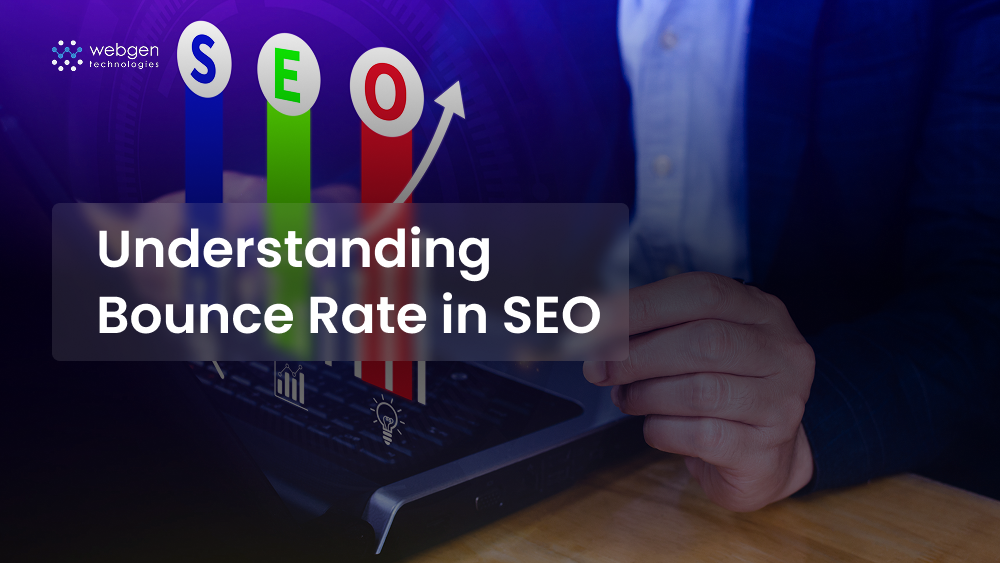In digital marketing, bounce rate is the unit to evaluate total website traffic. It provides an estimate of how often people leave a website before viewing other pages of the site.
The “visitor drop-off rate” is a term frequently used when tracking bounce rate. However, it is a single-page session rate, and the drop-off is the proportion of visitors who leave the website, regardless of their actions later, i.e., the number of pages they should have visited.
This blog will cover everything related to bounce rates, including how they are calculated, how they differ from exit rates, and how you can improve your website’s bounce rate.
- What is The Bounce Rate for a Website?
- Bounce Rate vs. Exit Rate – What Differentiates Both?
- What Calls for a Good Bounce Rate?
- High Bounce Rate Causes – How Does it Matter?
- Understand How to Improve Your Website’s Bounce Rate
- Why Is Monitoring Your Website’s Bounce Rate Important?
- How Important Is Bounce Rate for SEO Ranking?
- Final Words
What is The Bounce Rate for a Website?
To calculate a website’s bounce rate, a formula is followed: that is, the number of landing or single-page visits / total number of visits X 100. Considering the formula and compared to other web analytics subjects, the definition of bounce rate is easy to understand. However, this does not imply that the information is insignificant or superficial, but a bounce rate evaluation could provide a wealth of information. Digital marketing experts of the best SEO company in Kolkata describe it as the total number of visitors leaving your website without browsing other pages.
Is a high bounce rate necessarily viewed negatively? Well, not often.
The bounce rate varies significantly when compared to the industry standard. Depending on the kind of website and the source of traffic, the concept of a “good” bounce rate might be unjustified. The majority of websites have bounce rates that range from 25% to 75%. It is very unusual to get a bounce rate below 20%, and you might want to delve into monitoring issues.
Bounce Rate vs. Exit Rate – What Differentiates Both?
The words “exit rate” and “bounce rate” are sometimes used interchangeably when discussing Google Analytics, a part of digital marketing services. These two measures, however, assess distinct things and offer different perspectives on user activity.
Here are the key differences:
- A bounce occurs when a visitor opens a site’s page (landing page) and then leaves it immediately without closing. On the other hand, an exit occurs when a visitor navigates through several pages before leaving a particular page.
- When a session includes one pageview, particularly the landing page, but it’s not the only one, then it can be counted as a bounce. It might be a product page, service page, or even a blog page in this scenario.
- Bounce rates show if a landing page performs well by representing initial interaction. On the other hand, the exit rate of the website gives you an insight into the exact user visits and from which page they leave the website.
Although they are two distinct parameters, exit rate and bounce rate together provide insight into the important aspects of visitors’ activity on your website.
What Calls for a Good Bounce Rate?
You might consider your website to be doing well if its bounce rate is 40% or less. Always try to retain the percentage for bounce rates between the 26% and 40% mark. Since it’s typically unusual to go anyplace below 20%, you might want to double-check a few things if that’s what your data indicates.
Keep in mind, the average bounce rate might differ based on the device used by the viewer. However, mobile devices can have a 51% bounce rate compared to other devices, which is the highest. When talking about the tablets, they have an average bounce rate of 45%, followed by desktops having an average of 43%. Therefore, while evaluating the bounce rate of your website, consider the device type and go for bounce rate optimization.
High Bounce Rate Causes – How Does it Matter?
Bounce rates exceeding 70% are higher than average. Over 90% is a serious cause for concern, but it’s simple to decrease the rate. Nonetheless, a variety of things might cause you to feel worried. It could be due to things like design errors, mistakes in your site’s code, use of too many bots, or browser incompatibility.
One important metric for assessing how well website design and content hold users’ attention is bounce rate. It helps in studying user behavior trends and pinpointing areas that need improvement. An in-depth analysis of the content on particular sites or the traffic sources directing to them might prove necessary.
Remember some important factors: your target audiences can be mobile users, and there can be a contribution of traffic from social media or sponsored advertisements, which might all be adding up to your site’s increased bounce rate.
Understand How to Improve Your Website’s Bounce Rate
Normally, high bounce rates might suggest that site users might find the page meaningless or irrelevant. However, don’t immediately take immediate measures like redesigning or removing a page. Additionally, there are a few things you need to consider prior to reaching a decision.
1. Make Sure Your Website is Mobile-friendly
Approximately half of all online traffic comes from mobile users. Taking into account bounce rate and SEO ranking, it is therefore essential to not only provide a mobile-ready experience but also to ensure that the experience is engaging. It is no longer sufficient to have a responsive website; interaction with the mobile version must be easy to use and dynamic.
2. Check Your Webpages’ URLs
The website’s bounce rate might be influenced by the sources of traffic that enter the site. If you are experiencing a high bounce rate from your website visitors, check the URL carefully to make sure it is simple to read, remember, and execute.
After that, make sure the visitor isn’t encountering an unwelcoming home page loading error like a “404 error.” The title should tell the reader that they are at the correct location. Regardless of the source, you must live up to the visitor’s expectations and resolve issues by approaching the best digital marketing company in Kolkata.
3. Implement the Best Ranking Keyword on Your Website
An individual who searches for “marketing automation software solutions” is probably seeking software that will assist in turning leads into customers. However, if the visitor is searching for “What are marketing services?” The visitor would not be aware of the market or the services. Instead, this individual is searching for informational material above anything else.
Check your site’s bounce rate and SEO ranking to make sure the keywords are ranking the content when you review them. Then, to promote organic traffic to the appropriate pages, consider a topic-cluster structure, which organizes your site’s pages into clusters based on a theme.
4. Create an Engaging Website Design
Enhancing your website’s design to keep users interested is another strategy to boost page visits and increase session times. Making use of product-based visuals, strong color contrast, sensible font size, prominent call-to-action buttons, inline forms, and other techniques makes sense. Always remember the needs of your target audience while making such adjustments.
5. Focus More on Content Readability
Improving your blogs, articles, case studies, checklists, and other information to be easier to read is one of the best strategies to reduce your bounce rate. Users are more interested in spending time on websites that are well organized and contain easy-to-read content (text or images).
- Create a hierarchy by using subheadings and lines
- Highlight important information using bullets
- Keep the paragraph length within 3-4 lines
- Read and edit the content before publishing
Following the above-mentioned suggestions can help make your visitors more engaged with your content, hence improving the bounce rate of your website.
Why Is Monitoring Your Website’s Bounce Rate Important?
In today’s world of aggressive digital competition, tracking a page’s bounce rate and conversion rate is crucial, particularly for businesses. You might discover pages that aren’t drawing in, keeping, or engaging visitors. Additionally, this measure can point up other on-page issues you could be ignoring, such as –
- Improper page layout
- Unsatisfactory user experience
- Terrible copywriting
- The call to action not working
- Unrelated website content
Finding inefficient pages and other issues can help you create a report that offers practical advice on how to optimize a website to increase its functionality. As a business owner, you might get the chance to interact with potential customers and increase conversions, sales, and retention as a result.
Also Read: How AI is Changing the Way SEO is Done?
How Important Is Bounce Rate for SEO Ranking?
A high percentage of visitors leaving the site might be a sign of issues with either a particular page or your entire website. For instance, it could bring attention to issues with your site’s content, design, UX and UI, and other performance areas. All of these factors have a direct impact on how visitors perceive and interact with you. In turn, it is an important measure to monitor the SEO rankings of the site.
However, a high bounce rate might suggest that your site’s visitors are not finding what they are searching for. This can be an indicator of issues with your website’s design, content, or user experience.
You should stress how crucial it is to monitor the site’s SEO analytics. Although it might not have a direct impact on your ranking, it does have an impact on the user experience you provide and the efficiency of your website’s operation.
Final Words
By examining your site’s bounce rate, you can determine whether the information you offer is helpful to visitors. Remember, when it comes to bounce rates, there is no single-size-fits-all standard; providing a worthwhile online experience will provide different bounce rates.
When you take care of your visitors’ needs and make your pages more appealing, your website will stand out in the market. Therefore, the next thing to do is to improve the browsing experience of your website. Contact Webgen Technologies, a leading web development company in India, and start your journey with us today!







